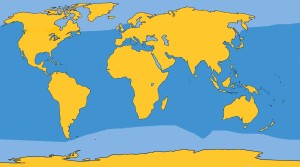Family: Ziphiidae
Genus: Ziphius
Species: Z. cavirostris Cuvier, 1823
Cuvier’s beaked whales are the most common of the “rare” beaked whales. Scientific specimens are known mostly from strandings throughout their worldwide range. Sightings of this species are infrequent as the blow is inconspicuous and the animals normally show little interest in ships.
Physical Description: There is a well-defined indentation on the dorsal region just behind the head. The cleft of the mouth is smaller than that of any other beaked whale, and the beak is indistinct in larger individuals. Typical wishbone indentations are found on the ventral region of the chin.
Color: Rusty red-brown dorsally, converging to darker brown on the flanks; dark brown or black ventrally. The forehead, chin, and mouth are white on older animals. Old males display a distinctive white head. The entire body, especially the ventral region, is covered with small white blotches caused by parasitic bacteria or protozoa. Most individuals are visibly scarred, probably from fights with older, aggressive males.
Fins and Flukes: The falcate dorsal fin is usually tall — up to 15 in (38 cm), and taller in Atlantic and Pacific animals than those of the Indian Ocean — and is located to the rear of the mid-back region. The flippers are small and rounded at the tips with straight leading edges; the back edges curve to meet the body. The large, well-defined flukes are rounded at the tips; they may or may not have a median notch.
Length and Weight: Cuvier’s beaked whales may reach about 23 ft (7 m) and exceed 5 tons (4,500 kg). Females are slightly larger than the males of the same age.
Teeth: A pair of teeth is located at the tip of the lower jaw in males. These teeth do not erupt visibly in females.
Feeding: Squid and deep-dwelling oceanic fish are known to be consumed.
Breathing and Diving: These are deep-diving animals, able to remain underwater as long as half an hour. Prior to their lengthy dives, they breathe two or three times at 10- to 20-second intervals, often raising their flukes high into the air at a 45-degree angle, then descending vertically. The blows are neither large nor obvious; the forehead, back, and dorsal fins are visible, but usually not the beak. These animals rarely breach and are wary of boats.
Mating and Breeding: Calves are born between 6.5 and 10 ft (2 and 3 m). Males are sexually mature at 18 ft (5.5 m); females 20 ft (6 m).
Herding: The average herd size is believed to be 2 to 6 individuals.
Distribution: These are cosmopolitan animals found in all oceans and seas except in the polar regions. They typically occur in waters of 3,300 ft (1,000 m) or deeper, often in the vicinity of sea canyons and escarpments.
Migration: No information available.
CUVIER’S BEAKED WHALE DISTRIBUTION








